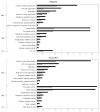Physiological and Molecular Responses of 'Dusa' Avocado Rootstock to Water Stress: Insights for Drought Adaptation
- PMID: 34685886
- PMCID: PMC8537572
- DOI: 10.3390/plants10102077
Physiological and Molecular Responses of 'Dusa' Avocado Rootstock to Water Stress: Insights for Drought Adaptation
Abstract
Avocado consumption is increasing year by year, and its cultivation has spread to many countries with low water availability, which threatens the sustainability and profitability of avocado orchards. However, to date, there is not much information on the behavior of commercial avocado rootstocks against drought. The aim of this research was to evaluate the physiological and molecular responses of 'Dusa' avocado rootstock to different levels of water stress. Plants were deficit irrigated until soil water content reached 50% (mild-WS) and 25% (severe-WS) of field capacity. Leaf water potential (Ψw), net CO2 assimilation rates (AN), transpiration rate (E), stomatal conductance (gs), and plant transpiration rates significantly decreased under both WS treatments, reaching significantly lower values in severe-WS plants. After rewatering, mild- and severe-WS plants showed a fast recovery in most physiological parameters measured. To analyze root response to different levels of drought stress, a cDNA avocado stress microarray was carried out. Plants showed a wide transcriptome response linked to the higher degree of water stress, and functional enrichment of differentially expressed genes (DEGs) revealed abundance of common sequences associated with water stress, as well as specific categories for mild-WS and severe-WS. DEGs previously linked to drought tolerance showed overexpression under both water stress levels, i.e., several transcription factors, genes related to abscisic acid (ABA) response, redox homeostasis, osmoprotection, and cell-wall organization. Taken altogether, physiological and molecular data highlight the good performance of 'Dusa' rootstock under low-water-availability conditions, although further water stress experiments must be carried out under field conditions.
Keywords: Persea americana; abiotic stress; microarray; water deprivation.
Conflict of interest statement
The authors declare no conflict of interest.
Figures







References
-
- Walter J., Nagy L., Hein R., Rascher U., Beierkuhnlein C., Willner E., Jentsch A. Do plants remember drought? Hints towards a drought-memory in grasses. Environ. Exp. Bot. 2011;71:34–40. doi: 10.1016/j.envexpbot.2010.10.020. - DOI
-
- Allen C.D., Breshears D.D., McDowell N.G. On underestimation of global vulnerability to tree mortality and forest die-off from hotter drought in the Anthropocene. Ecosphere. 2015;6:129. doi: 10.1890/ES15-00203.1. - DOI
-
- Nardini A., Gullo M.A.L., Trifilò P., Salleo S. The challenge of the Mediterranean climate to plant hydraulics: Responses and adaptations. Environ. Exp. Bot. 2014;103:68–79. doi: 10.1016/j.envexpbot.2013.09.018. - DOI
-
- Purseglove J.W. Tropical Crops: Dicotyledons. Longmans, Green and Co. Ltd.; London, UK: 1968. Persea americana Mill; pp. 192–198.
-
- Moreno-Ortega G., Pliego C., Sarmiento D., Barceló A., Martínez-Ferri E. Yield and fruit quality of avocado trees under different regimes of water supply in the subtropical coast of Spain. Agric. Water Manag. 2019;221:192–201. doi: 10.1016/j.agwat.2019.05.001. - DOI
Grants and funding
LinkOut - more resources
Full Text Sources
Molecular Biology Databases

